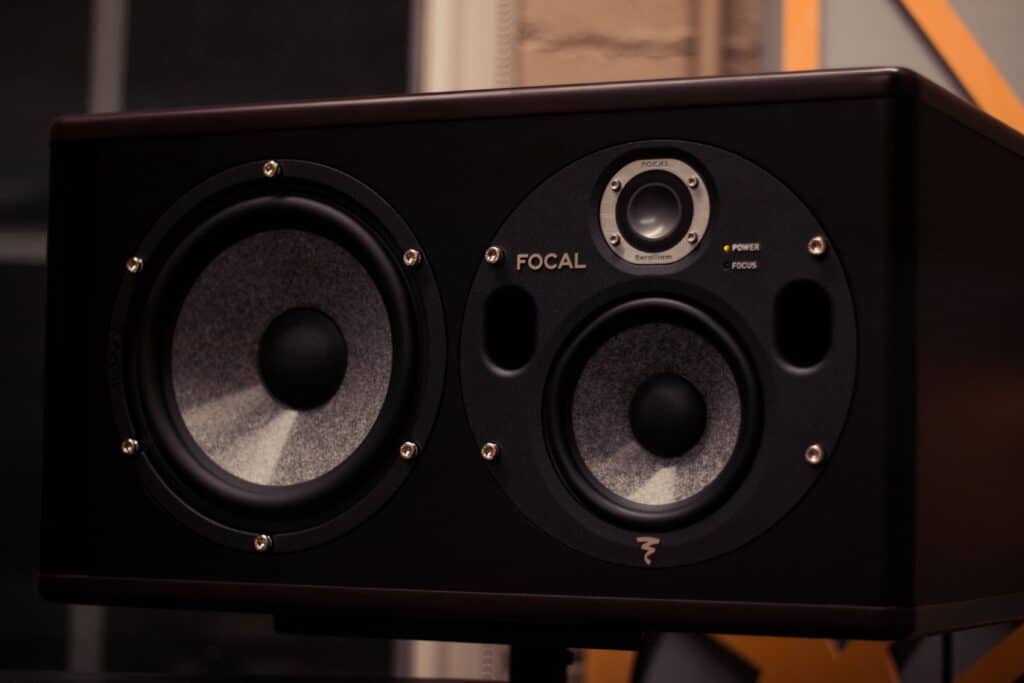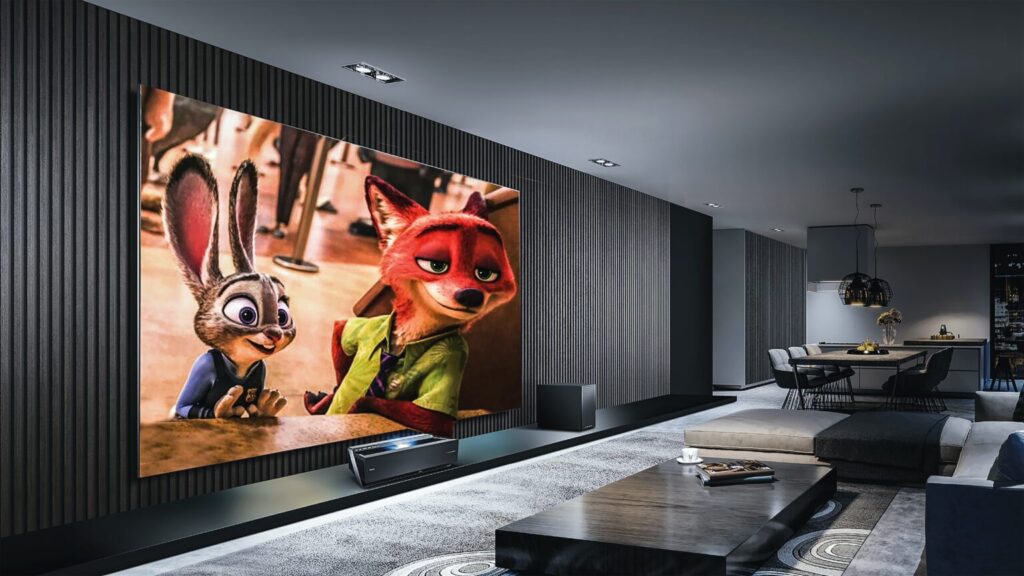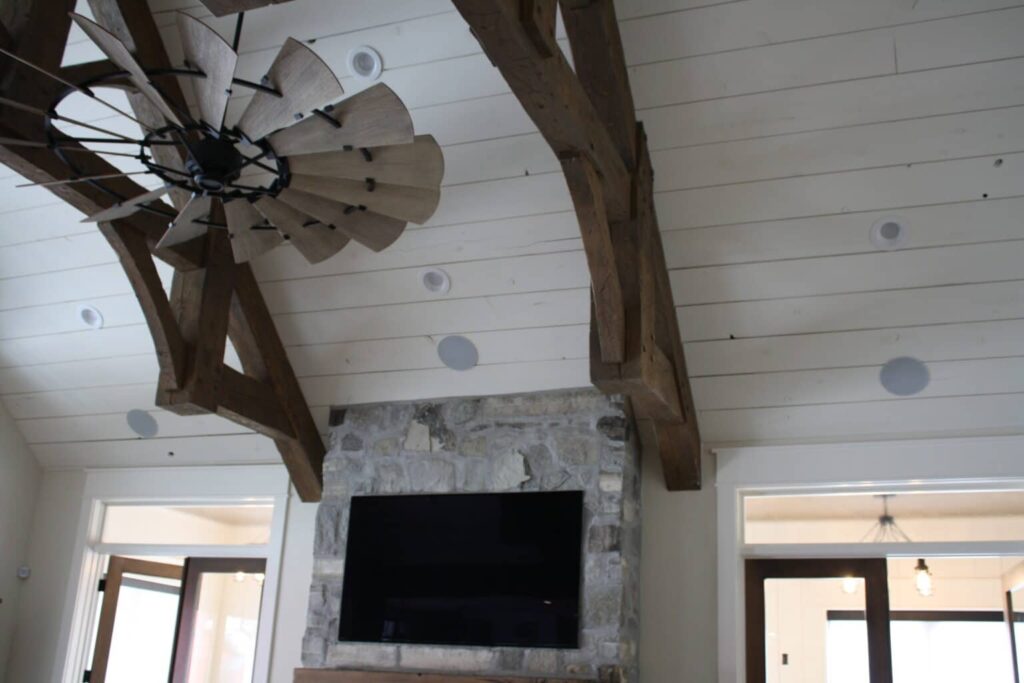Many homeowners ask, “What is a subwoofer?” or “Is a subwoofer necessary?” when considering buying or upgrading their home audio systems. The best home audio system experience is more than a few speakers to plug in, especially for homeowners considering investing in home automation. From enhancing sound quality to preventing audio distortion, subwoofers play a crucial role in any smart home sound system.
Below we’ll explain what a subwoofer is, how it works, the benefits of adding one to your home sound system, and tips on choosing the right one. Whether you’re a music lover, enjoy family movie nights, or have children who are video game and streaming enthusiasts, here’s how to take your smart home audio sound system to the next level with subwoofers — and why they’re worth it.
What is a subwoofer?
A subwoofer is a key part of any surround sound or home audio system. Think of it as the speaker that brings the bass—the deep, rumbling low-frequency sounds that make music, movies, and games feel more intense and immersive.
Subwoofers are all about adding that extra depth to your audio. Whether you’re setting up a home theater, love watching movies, or spend hours gaming, a subwoofer helps deliver that cinematic or lifelike sound experience. It’s what gives explosions their boom, music its punch, and every sound effect that extra wow factor.
Low vs. Mid-Range vs. High-Frequency Audio: What’s the Difference?
As mentioned, subwoofers (or subs) produce low-frequency audio, also known as bass. Subs don’t produce mid-range to high-frequency audio. The types of surround sound that produce mid-range audio (bass and treble) are mid-range speakers, and high-frequency audio (treble) is produced by tweeters.
Subwoofers, mid-range speakers, and tweeters are all speaker components of a surround sound system to produce a complete sound range — also known as the audio frequency spectrum.
| Subwoofers | Mid-Range Speakers | Tweeters |
| Low-frequency audio (bass) | Mid-range audio (bass and treble) | High-frequency audio (treble) |
| Typically 20-200 Hz | Typically 200 Hz – 4 kHz | Typically 4 kHz-20 kHz |
The power of a speaker’s audio frequency output is measured in hertz (Hz). The audio frequency output to look for in a subwoofer depends on how it’s used. For homes, it’s recommended to set a limit for the subwoofer’s frequency range to 100 Hz and below with a crossover.
Although some subwoofers can produce tones below 20 Hz, the bass will most likely not be heard due to limited human hearing capabilities. There are audio frequency limits in which a person can hear, and ensuring your subwoofer’s crossover frequency is set to the right range is crucial to the surround sound experience.
What is a crossover on a subwoofer?
For homeowners wondering, “What is a crossover on a subwoofer?”, they’re electronic filters that help split a subwoofer’s audio frequency – also known as, crossover frequency. Crossovers determine the highest and lower notes subwoofers play without straining their sound quality output.
Below are the three types of subwoofer crossovers and how they impact audio frequency output:
- Low-pass crossover filters — filter out all signals above a set crossover frequency
- High-pass crossover filters — filter out all signals below a set crossover frequency
- Band-pass crossover filters — filter out all signals except ones within a set crossover frequency range
As mentioned above, a subwoofer’s crossover frequency rate is typically between 20-200 Hz. Most subwoofers and surround sound systems have user frequency settings to customize crossover frequency.
Subwoofer Crossover Frequency Recommendations for Home Audio Systems
The best crossover frequency for a subwoofer depends on its use and room size. It’s best practice to reference the speaker’s spec sheet, owner’s manual, or manufacturer’s website as a starting point for crossover frequency settings.
As a general standard, 80 Hz is typical for larger spaces like home theater rooms. For smaller rooms and speakers, it can vary, but try starting around 120 Hz and customizing the settings from there.
At AIS, we understand that crossover frequency settings can be confusing, especially when each home has a unique space with varying sound requirements. Our custom integrators can help you decide the best crossover settings for your subwoofer and surround sound system type.

Types of Subwoofers for Home Audio Systems: Powered vs. Passive Subwoofers
Another common question homeowners ask about subwoofers is, “What does a subwoofer do?” or “How does a subwoofer work?” The answer to those questions depends on the type of subwoofer that’s being used.
Below we’ll break down the most common types of subwoofers used and how they work.
What is a powered subwoofer?
Powered subwoofers, also known as active subwoofers, are subwoofers with a built-in amplifier or A/V (Audio/Visual) receiver built in. They require less power from amplifiers or A/V receivers since they’re built within the subwoofer.
Active subwoofers are typically bigger and ideal for larger rooms like home movie theater setups and outdoor audio because they produce a more powerful sound than passive subwoofers. Additionally, since active subwoofers have amplifiers or A/V receivers built-in versus external connections, they tend to cost more.
| Powered/Active Subwoofers | Passive Subwoofers |
| Bigger structure | Smaller structure |
| Built-in amplifiers or A/V receivers | External amplifiers or A/V receivers required |
| Powerful low-frequency audio | Less intense low-frequency audio |
| Ideal for larger rooms | Ideal for smaller rooms |
| Higher costs | Lower costs |
What is a passive subwoofer?
Passive subwoofers are speakers that require an external amplifier or A/V (Audio/Video) receiver to power. In contrast to powered subwoofers, it doesn’t have an amplifier and A/V receiver built in and requires an external connection.
Passive subwoofers are smaller and require additional power to produce low-frequency audio (bass). The A/V receiver or amplifier receives these sounds and sends the subwoofer extra power to produce bass without draining its power supply.
Passive subwoofers are ideal for smaller areas of the home, like limited living room spaces or video game rooms, because it requires less intense sound. If a subwoofer is too loud or powerful for a small room, it can risk hearing damage, so investing in the right subwoofer type is vital.

4 Benefits of Adding a Subwoofer to Your Home Audio System
Now that you know “What is a subwoofer?” and the different types available, here are the benefits of adding subwoofers to smart home audio systems.
1. Compatible with Smart Home Technology
One of the most convenient benefits of subwoofers is their compatibility with home automation. Subwoofers can be integrated into whole-home audio, surround sound, home movie theaters, landscape audio, and more for an elevated entertainment experience.
Here are some smart home benefits of integrating subwoofers into home automation:
- Manage the entire home audio system remotely easily via a smart device or home automation control system like ELAN
- Custom program music schedules for getting ready routines or family celebrations
- Preset volume settings that adjust automatically based on dynamic audio for a better listening experience in films, TV, music, video games, etc.
- Listen to audio and video in every room of the house through integrated hard drives
Whether it’s backyard pool parties, gaming rooms, or home movie theaters, subwoofers can enhance any smart home significantly.
2. Improves Home Audio & Surround Sound Quality
All smart surround sound systems benefit from subwoofers. The bass and deeper sounds produced by subwoofers help the audio to sound the way it’s designed to sound. If the bass is cut from the audio, you won’t have the entire audio experience. Subwoofers complete any surround sound and audio system to give goosebumps when watching movies, TV, and overall entertainment.
3. Enhances Sound Depth and Dimension
Subwoofers are more than providing bass to a home audio or surround sound system. They enhance audio depth and dimension by providing balanced sound profiles. Imbalanced audio systems can cause ear strain, miss key background noises, and cheapen the A/V (Audio & Visual) experience.
Subwoofers produce low-frequency audio and are an extension of a surround sound system. Other speakers typically found in audio systems include mid-range speakers (mid-frequency) and tweeters (high-frequency) — together, they complete the audio spectrum. Adding a subwoofer to a surround sound system completes the A/V experience to produce high-quality entertainment at home.
4. Handles Heavy Bass Without Distortion
A high-quality subwoofer can produce low-frequency audio without distorting the rest of the surround sound or home audio system. Subwoofers should be able to play heavy bass in explosions from action-packed movies, goosebump music in horror films, vibrations from video game soundtracks, and more without a muffled audible sound. Adding a subwoofer to a home audio system adds dramatic surround sound effects for the best at-home entertainment.
How to Choose the Right Subwoofer for Your Home Audio System
Now that you know the answer to “What is a subwoofer?” and the types available, here’s how to choose the right one for your smart home audio system.
Room Size & Functionality
Room size and function significantly impact the type of subwoofer to buy for a smart home audio system. The first step should be considering what you’ll use the space for most. Is it for a home movie theater, video games, sports, home parties, or family celebrations? Understanding how the subwoofer will function for the space it’s going in will help dictate the subwoofer type you need.
For example, if there’s limited room available, consider using invisible subwoofers. Also known as architectural speakers, they’re installed in-wall or in-ceiling to maximize the space and entertainment experience without taking up additional room. For larger rooms like home movie theaters, louder subwoofers are recommended to ensure consistent sound quality throughout the space.
At AIS, we understand that subwoofer shopping can be confusing for homeowners or challenging for those who want to upgrade their surround sound system simply. We offer consultations and subwoofer recommendations for your unique space and needs.
Subwoofer Placement: Architectural vs. Standard Speakers
The second biggest impact on the type of subwoofer to buy also depends on subwoofer placement. So, where should a subwoofer be placed? It depends if you’re investing in invisible or visible speakers.
Invisible subwoofers, or architectural speakers, can be installed in-wall or in-ceiling to maximize space. Standard subwoofers are best placed in the room corners, but they can also be near walls or in other positions that produce the best results for your specific setup.

Subwoofer Placement Tips for Homeowners
If your subwoofer isn’t producing the desired surround sound effect, try moving it to a different location or toe-in placements. A toe-in placement points the subwoofers toward your listening position and slightly angles them so all the audio is directed toward you. This subwoofer placement type maximizes the surround effect and improves the overall sound quality.
If the room has an extra subwoofer, we recommend placing them opposite of one another (front and back) or in a catty corner from one another.
Need advice on the best subwoofer placement for your home? At AIS, we can help you find the perfect subwoofer placement in a home theater, individual rooms, backyards, and more. Skip the hassle of figuring out your ideal subwoofer placement and contact us for the best possible audio results.
Subwoofer Brand Recommendations from AIS
With the fundamentals of subwoofers covered, the brands to buy from are equally important. A surround sound system with a low-quality subwoofer can ruin the audio experience easily with muffled bass.
Below are the best subwoofer brands recommended by the AIS pros:
- James Loudspeaker — high-performing luxury design with multiple sizes and configurations
- Monitor Audio — in-wall subwoofers with pre-set dynamic ranges and bass extensions
- Sonance — invisible or in-wall subwoofers designed for discreet performance audio
- Sonos — practical option for wireless subwoofers if you can’t connect a coaxial cable to a wired subwoofer (wired subwoofers are always suggested over wireless)
Once you know the subwoofer brand you want to buy, searching for smart home audio system installers is the final step. Always use HTA-certified system integrators when installing home automation systems, devices, and equipment for the best possible results.to
At AIS, we’re proud to be an HTA Design Partner for the Home Technology Association (HTA) to provide homeowners with the best integration services for their smart home technology. Subwoofers and smart home audio systems are investments, so getting them integrated by qualified home automation professionals is essential for the best experience.
Subwoofer FAQs
Do I really need a subwoofer for my home audio system?
While you can technically run a sound system without a subwoofer, you’ll miss out on the full audio spectrum; especially the deep, low-frequency bass that brings music, movies, and games to life. A subwoofer completes your sound system by delivering the low-end frequencies that standard speakers can’t handle.
What’s the difference between powered and passive subwoofers?
Powered (active) subwoofers have built-in amplifiers, making them ideal for larger spaces or home theaters that need powerful bass output. Passive subwoofers, on the other hand, rely on an external amplifier or A/V receiver for power and are better suited for smaller rooms or setups with limited space.
Where should I place my subwoofer for the best sound?
Placement depends on the room layout and the type of subwoofer you’re using. Standard subwoofers often sound best near room corners or walls to amplify bass, while architectural subwoofers can be built into walls or ceilings for a clean, space-saving design. For optimal balance, try experimenting with placement or consult a professional integrator for calibration.
What’s the ideal crossover frequency for a subwoofer?
For most home audio systems, a crossover frequency around 80 Hz is recommended for larger rooms, while smaller spaces may perform better around 100–120 Hz. These settings help ensure your subwoofer blends seamlessly with the rest of your speakers without overpowering the sound.
Upgrade to a Smart Home Audio System with AIS
Adding a subwoofer to a smart audio sound system is a worthy investment because it significantly improves sound quality and enhances any home entertainment experience. Whether watching movies, listening to music, or playing video games, subwoofers can take your entertainment to the next level.
Now that you know the answer to “What is a subwoofer?”, you’re one step closer to making your dream home audio system. Use our budget calculator to determine your options or contact us for help with subwoofers and smart home audio systems today!



